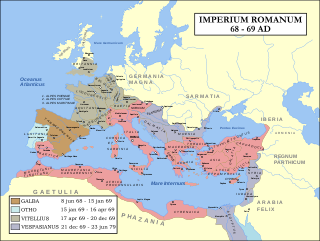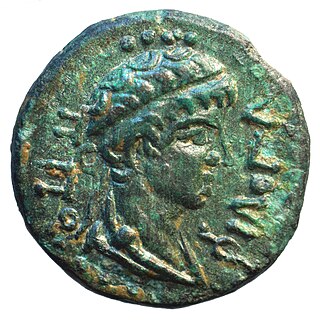
AD 69 (LXIX) was a common year starting on Sunday of the Julian calendar. At the time, it was known as the Year of the Consulship of Augustus and Rufinus. The denomination AD 69 for this year has been used since the early medieval period, when the Anno Domini calendar era became the prevalent method in Europe for naming years.

AD 79 (LXXIX) was a common year starting on Friday of the Julian calendar. At the time, it was known as the Year of the Consulship of Titus and Vespasianus. The denomination AD 79 for this year has been used since the early medieval period, when the Anno Domini calendar era became the prevalent method in Europe for naming years.

The 60s decade ran from January 1, AD 60, to December 31, AD 69.

The 70s was a decade that ran from January 1, AD 70, to December 31, AD 79.
AD 70 (LXX) was a common year starting on Monday of the Julian calendar. At the time, it was known as the Year of the Consulship of Vespasian and Titus. The denomination AD 70 for this year has been used since the early medieval period, when the Anno Domini calendar era became the prevalent method in Europe for naming years.

AD 66 (LXVI) was a common year starting on Wednesday of the Julian calendar. At the time, it was known as the Year of the Consulship of Telesinus and Paullinus. The denomination AD 66 for this year has been used since the early medieval period, when the Anno Domini calendar era became the prevalent method in Europe for naming years.
AD 67 (LXVII) was a common year starting on Thursday of the Julian calendar. At the time it was known as the Year of the Consulship of Julius Rufus and Fonteius Capito. The denomination AD 67 for this year has been used since the early medieval period, when the Anno Domini calendar era became the prevalent method in Europe for naming years.
AD 71 (LXXI) was a common year starting on Tuesday of the Julian calendar. At the time, it was known as the Year of the Consulship of Vespasian and Nerva. The denomination AD 71 for this year has been used since the early medieval period, when the Anno Domini calendar era became the prevalent method in Europe for naming years.

AD 73 (LXXIII) was a common year starting on Friday of the Julian calendar. At the time, it was known as the Year of the Consulship of Domitian and Messalinus. The denomination AD 73 for this year has been used since the early medieval period, when the Anno Domini calendar era became the prevalent method in Europe for naming years.
AD 92 (XCII) was a leap year starting on Sunday of the Julian calendar. At the time, it was known as the Year of the Consulship of Augustus and Saturninus. The denomination AD 92 for this year has been used since the early medieval period, when the Anno Domini calendar era became the prevalent method in Europe for naming years.
Year 38 BC was either a common year starting on Sunday or Monday or a leap year starting on Saturday, Sunday or Monday of the Julian calendar and a common year starting on Sunday of the Proleptic Julian calendar. At the time, it was known as the Year of the Consulship of Pulcher and Flaccus. The denomination 38 BC for this year has been used since the early medieval period, when the Anno Domini calendar era became the prevalent method in Europe for naming years. It was also the first year of the Spanish era calendar in use in Hispania until the 15th century.

Gaius Julius Antiochus IV Epiphanes, the last king of Commagene, reigned between 38 and 72 as a client king to the Roman Empire. The epithet "Epiphanes" means "the Glorious".

Lucius Flavius Silva Nonius Bassus was a late-1st-century Roman general, governor of the province of Iudaea and consul. Silva was the commander of the army, composed mainly of the Legio X Fretensis, in 72 AD which laid siege to the near-impregnable mountain fortress of Masada, occupied by a group of Jewish rebels called the Sicarii. The siege ended in 73 AD with Silva's forces breaching the defenses of the Masada plateau and the mass suicide of the Sicarii, who preferred death to defeat or capture. Silva's actions are documented by 1st-century Jewish-Roman historian Josephus, the remains of a 1st-century Roman victory arch identified in Jerusalem in 2005, and the extensive earthworks at the Masada site, a monument to the high-water mark of Roman siege warfare.

Gaius Julius Antiochus Epiphanes Philopappos or Philopappus, was a Prince of the Kingdom of Commagene who lived in the Roman Empire during the 1st century and 2nd century. He was one of the most prominent Greeks in the Empire.

Commagene was an ancient Greco-Iranian kingdom ruled by a Hellenized branch of the Iranian Orontid dynasty that had ruled over Armenia. The kingdom was located in and around the ancient city of Samosata, which served as its capital. The Iron Age name of Samosata, Kummuh, probably gives its name to Commagene.
Julia Balbilla was a Roman noble woman and poet. Whilst in Thebes, touring Egypt as part of the imperial court of Hadrian, she inscribed three epigrams which have survived.
Gaius Julius Archelaus Antiochus Epiphanes, also known as Julius Archelaus Epiphanes; Epiphanes; Gaius Julius Antiochus Epiphanes or simply known as Gaius was an influential prince of the Kingdom of Commagene, who lived in the 1st century.
Callinicus was a prince of the Kingdom of Commagene, who lived in the 1st century. Callinicus was the second-born son and child to King Antiochus IV of Commagene and Queen Iotapa of Commagene. His parents were full-blooded siblings. His parents were Roman Client Monarchs of Commagene that lived under the Roman Empire in the 1st century. His older brother was prince Gaius Julius Archelaus Antiochus Epiphanes and youngest sibling was princess Iotapa.
Claudia Capitolina was an Egyptian Greek woman who lived in the Roman Empire, in the 1st century and possibly in the 2nd century. She was a Princess of Commagene by marriage to Gaius Julius Archelaus Antiochus Epiphanes.
Lucius Junius Caesennius Paetus was a Roman senator, and member of the gens Caesennia and Junia, who held several offices in the emperor's service. He was consul ordinarius for the year 61 as the colleague of Publius Petronius Turpilianus. Judith Ginsburg notes this made him the first novus homo to reach the ordinary consulship since Quintus Veranius 12 years before.








